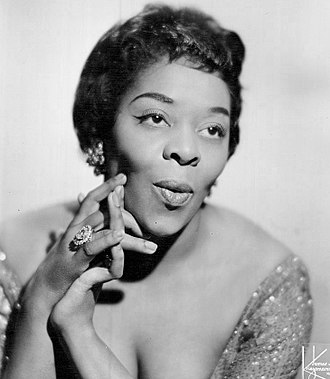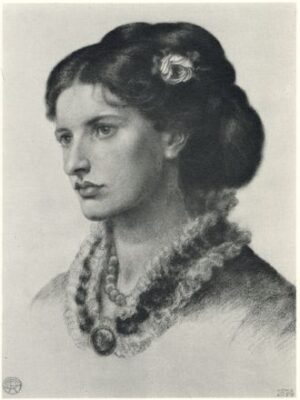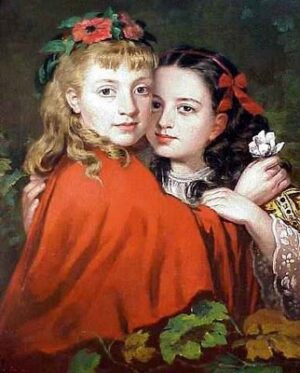Early life

Ruth Lee Jones was born on August 29 1924 to Alice and Ollie Jones in Tuscaloosa, Alabama. As a child she and her family moved to Chicago as a child.
Ruth became deeply involved in gospel music and played piano for the choir in St. Luke’s Baptist Church while still in elementary school. She sang gospel music in church and played piano, directing her church choir in her teens and was a member of the Sallie Martin Gospel Singers.
When Ruth joined the Sallie Martin group, she dropped out of Wendell Phillips High School. She sang lead with the first female gospel singers formed by Sallie Martin, who was co-founder of the Gospel Singers Convention.
Ruth‘s involvement with the gospel choir occurred after she won an amateur contest at Chicago’s Regal Theater where she sang “I Can’t Face the Music”.
Career
After winning a talent contest at the age of 15, Ruth began performing in clubs. By 1941–42 she was performing in such Chicago clubs as Dave’s Café and the Downbeat Room of the Sherman Hotel (with Fats Waller).
Ruth was playing at the Three Deuces, a jazz club, when a friend took her to hear Billie Holiday at the Garrick Stage Bar. Club owner Joe Sherman was so impressed with her singing of “I Understand”, backed by the Cats and the Fiddle, who were appearing in the Garrick‘s upstairs room, that he hired her.
During her year at the Garrick—Ruth sang upstairs while Holiday performed in the downstairs room—she acquired the name by which she became known. Dinah credited Joe Sherman with suggesting the change from Ruth Jones, made before Lionel Hampton came to hear Dinah at the Garrick. Hampton‘s visit brought an offer and Dinah worked as his female band vocalist after she had sung with the band for its opening at the Chicago Regal Theatre.
Dinah made her recording debut for the Keynote label that December with “Evil Gal Blues”, written by Leonard Feather and backed by Hampton and musicians from his band, including Joe Morris (trumpet) and Milt Buckner (piano).
Both that record and its follow-up, “Salty Papa Blues”, made the Billboard “Harlem Hit Parade” in 1944. In December 1945 she made a series of twelve recordings for Apollo Records, 10 of which were issued, featuring the Lucky Thompson All Stars.
Dinah stayed with Hampton‘s band until 1946, after the Keynote label folded, and signed for Mercury Records as a solo singer. Her first record for Mercury, a version of Fats Waller‘s “Ain’t Misbehavin‘“, was another hit, starting a long string of success.
Between 1948 and 1955, Dinah had 27 R&B top-10 hits, making her one of the most popular and successful singers of the period. Both “Am I Asking Too Much” (1948) and “Baby Get Lost” (1949) reached Number 1 on the R&B chart, and her version of “I Wanna Be Loved” (1950) crossed over to reach Number 22 on the US pop chart. Her hit recordings included blues, standards, novelties, pop covers, and even a version of Hank Williams‘ “Cold, Cold Heart” (R&B Number 3, 1951).
At the same time as her biggest popular success, she also recorded sessions with many leading jazz musicians, including Clifford Brown and Clark Terry on the album Dinah Jams (1954), and also recorded with Cannonball Adderley and Ben Webster.
In 1950, Dinah performed at the sixth famed Cavalcade of Jazz concert held at Wrigley Field in Los Angeles which was produced by Leon Hefflin, Sr. on June 25. Also featured on the same day were Lionel Hampton, PeeWee Crayton’s Orchestra, Roy Milton and his Orchestra, Tiny Davis and Her Hell Divers, and other artists.
There were 16,000 reported to be in attendance and the concert ended early because of a fracas while Lionel Hampton played “Flying High”. Dinah returned to perform at the twelfth Cavalcade of Jazz also at Wrigley Field in Los Angeles on September 2, 1956. Also performing that day were Little Richard, The Mel Williams Dots, Julie Stevens, Chuck Higgin’s Orchestra, Bo Rhambo, Willie Hayden & Five Black Birds, The Premiers, Gerald Wilson and His 20-Pc. Recording Orchestra and Jerry Gray and his Orchestra.
In 1959, Dinah had her first top ten pop hit, with a version of “What a Diff’rence a Day Made”, which made Number 4 on the US pop chart. Her band at that time included arranger and conductor Belford Hendricks, with Kenny Burrell (guitar), Joe Zawinul (piano) and Panama Francis (drums).
She followed it up with a version of Irving Gordon‘s “Unforgettable” and then two highly successful duets in 1960 with Brook Benton, “Baby (You’ve Got What It Takes)” (No. 5 Pop, No. 1 R&B) and “A Rockin’ Good Way (To Mess Around and Fall in Love)” (No. 7 Pop, No. 1 R&B). Dinah‘s last big hit was “September in the Rain” in 1961 (No. 23 Pop, No. 5 R&B).
Dinah notably performed two numbers in the dirty blues genre. The songs were “Long John Blues” about her dentist, with lyrics like “He took out his trusty drill. Told me to open wide. He said he wouldn’t hurt me, but he filled my whole inside.” She also recorded a song called “Big Long Slidin’ Thing”, supposedly about a trombonist.
One source states that Dinah “produced 45 R&B-charted hits between 1948 and 1961, including 16 Top 15 placements between 1948 and 1950”.
In the 1950s and early 1960s before her death, Washington occasionally performed on the Las Vegas Strip. Tony Bennett said of Dinah during a recording session with Amy Winehouse:
She was a good friend of mine, you know. She was great. She used to just come in with two suitcases in Vegas without being booked. … And she’d stay as long as she wanted. And all the kids in all the shows on the Strip would come that night. They’d hear that she’s in town and it would be packed just for her performance.
According to Richard S. Ginell at AllMusic:
[Washington] was at once one of the most beloved and controversial singers of the mid-20th century – beloved to her fans, devotees, and fellow singers; controversial to critics who still accuse her of selling out her art to commerce and bad taste. Her principal sin, apparently, was to cultivate a distinctive vocal style that was at home in all kinds of music, be it R&B, blues, jazz, middle of the road pop – and she probably would have made a fine gospel or country singer had she the time. Hers was a gritty, salty, high-pitched voice, marked by absolute clarity of diction and clipped, bluesy phrasing.
Dinah was well known for singing torch songs. In 1962, she hired a male backing trio called the Allegros, consisting of Jimmy Thomas on drums, Earl Edwards on sax and Jimmy Sigler on organ. Edwards was replaced on sax by John Payne. A Variety writer praised their vocals as “effective choruses”.
Dinah‘s achievements included appearances at the Newport Jazz Festival (1955–1959), the Randalls Island Jazz Festival in New York City (1959) and the International Jazz Festival in Washington, D.C. (1962), frequent gigs at Birdland (1958, 1961–1962), and performances in 1963 with Count Basie and Duke Ellington.
Personal life & death
Dinah was married seven times although according to other sources she had eight or nine husbands.
Early in the morning of December 14, 1963, Dinah‘s sixth husband, football great Dick “Night Train” Lane, went to sleep with Dinah and awoke later to find her slumped over and not responsive.
Dr. B. C. Ross pronounced her dead at the scene at age 39. An autopsy later showed a lethal combination of secobarbital and amobarbital, prescriptions for her insomnia and diet, which contributed to her death.
Dinah is buried in the Burr Oak Cemetery in Alsip, Illinois.


